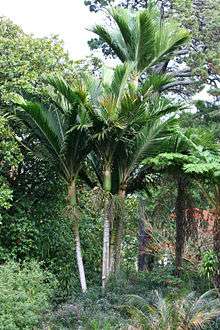Rhopalostylidinae
Rhopalostylidinae is a botanical subtribe consisting of two genera of palms from Australia and New Zealand, Hedyscepe and Rhopalostylis. These two genera were formerly included in Archontophoenicinae, to which they are morphologically similar (Dowe 2010:233), until a recent revision (Dransfield, Uhl et al., 2005).
| Rhopalostylidinae | |
|---|---|
 | |
| Rhopalostylis baueri | |
| Scientific classification | |
| Kingdom: | Plantae |
| Clade: | Tracheophytes |
| Clade: | Angiosperms |
| Clade: | Monocots |
| Clade: | Commelinids |
| Order: | Arecales |
| Family: | Arecaceae |
| Subfamily: | Arecoideae |
| Tribe: | Areceae |
| Subtribe: | Rhopalostylidinae |
| Genera | |
Description
The palms in this subtribe are medium-sized palms, with well-developed, distinct crownshafts and strictly pinnate leaves with generally short and massive petioles. The inflorescences are branched to two or three orders, with the prophyll and penduncular bracts similar (Uhl and Dransfield 1987:367).
Genera
The genus Rhopalostylis contains two species, R. baueri, the Norfolk palm or Niau, from Norfolk Island, Australia, and Raoul Island in the Kermadec group north of New Zealand, and R. sapida, the Nikau palm, from New Zealand. The leaves of Rhopalostylis tend to be held rigidly upright, especially in R. sapida from the northern North Island, making the palm somewhat resemble a feather duster.
Hedyscepe contains a single species, H. canterburyana the Big Mountain palm, which grows on mountain cliffs overlooking the sea on Lord Howe Island, Australia. However some studies throw doubt on the inclusion of Hedyscepe as a member of the Rhopalostylidinae. In some (but not all) molecular phylogenetic analyses, Hedyscepe is nested in the New Caledonia endemic Basselinia.[1]
References
- Baker, W. J.; Norup, M. V.; Clarkson, J. J.; Couvreur, T. L. P.; Dowe, J. L.; Lewis, C. E.; Pintaud, J. C.; Savolainen, V.; Wilmot, T.; Chase, M. W. (2011). "Phylogenetic Relationships among Arecoid Palms (Arecaceae: Arecoideae)". Annals of Botany. 108 (8): 1417–32. doi:10.1093/aob/mcr020. PMC 3219489. PMID 21325340.
- Dransfield, John; Uhl, Natalie W; Asmussen, Conny B; Baker, William J; Harley, Madeline M; Lewis, Carl E (2005). "A new phylogenetic classification of the palm family, Arecaceae". Kew Bulletin. 60.
- Dowe, John Leslie (2010). Australian Palms: Biogeography, Ecology And Systematics. Collingwood, Victoria: CSIRO Publishing.
- Norup, Maria Vibe; John Dransfield; Mark W. Chase; Anders S. Barfod; Edwino S. Fernando; William J. Baker (2006). "Homoplasious character combinations and generic delimitation: a case study from the Indo-Pacific arecoid palms (Arecaceae: Areceae)". American Journal of Botany. 93 (7): 1065–1080. doi:10.3732/ajb.93.7.1065. PMID 21642171. Retrieved 2008-05-08.
- Uhl, Natalie W; Dransfield, John (1987). Genera Palmarum - A classification of palms based on the work of Harold E. Moore. Lawrence, Kansas: Allen Press. ISBN 978-0-935868-30-2.